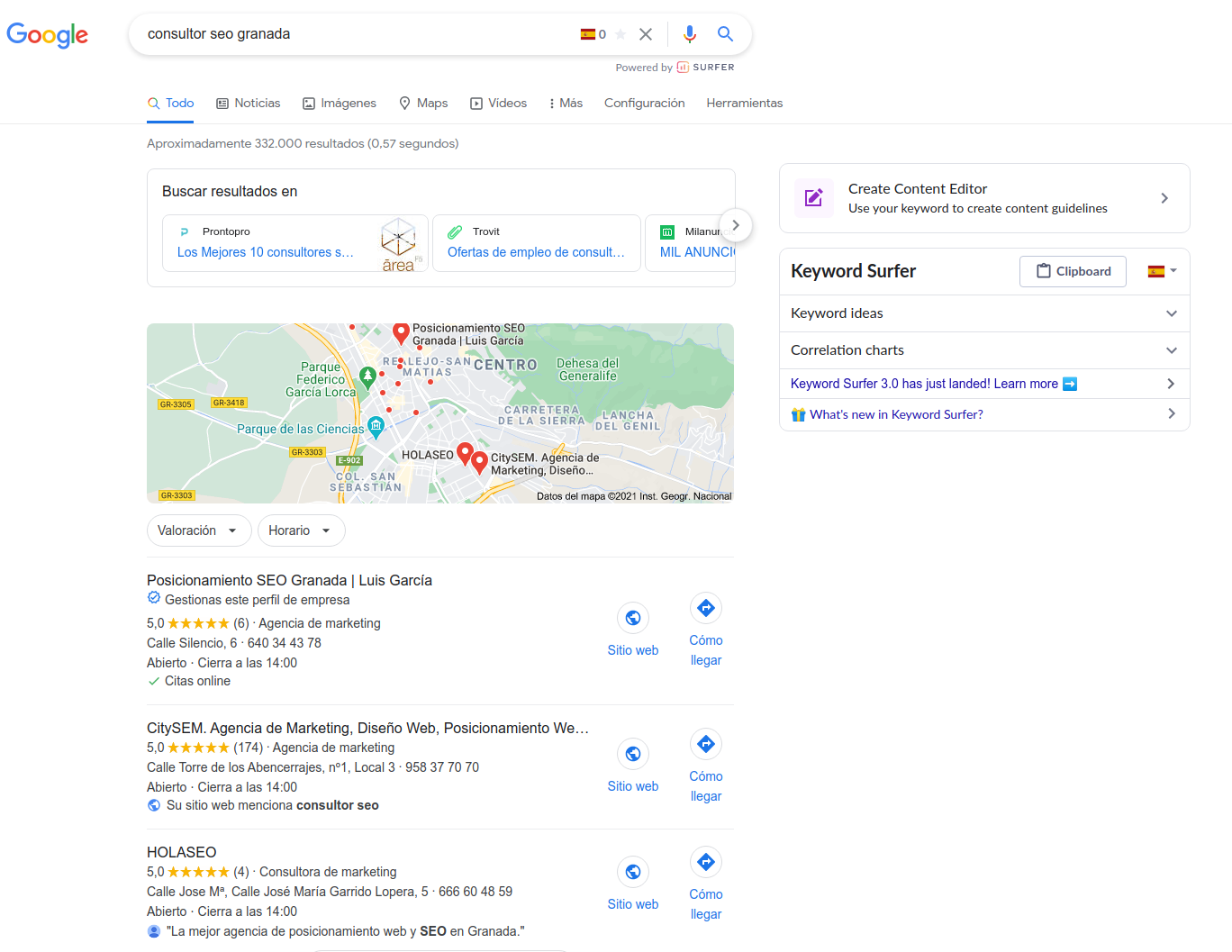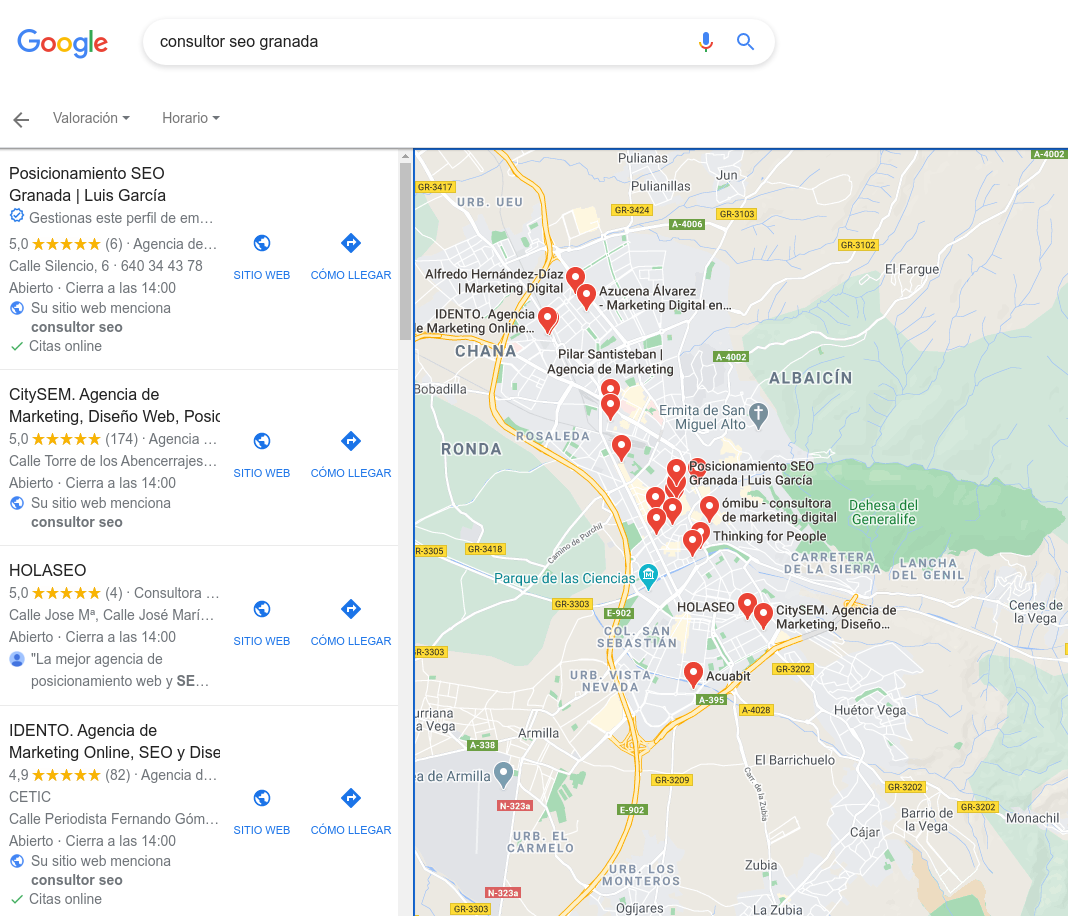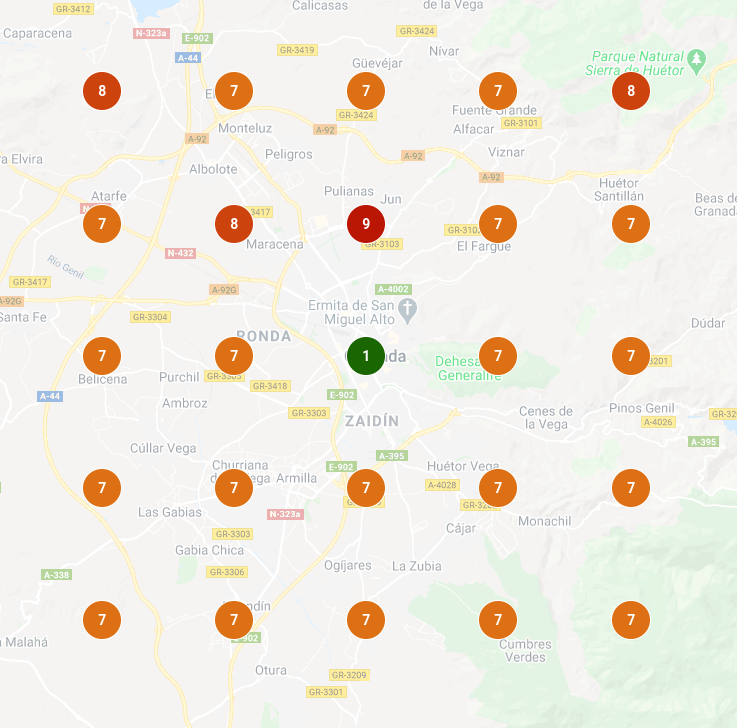Among the various SEO disciplines and their applications, there’s one very specific one that deserves special mention: Local SEO. This aspect of SEO focuses on positioning businesses in Google’s local search results, both in the general SERP and on the map.
Introduction to Local SEO
This positioning is geared toward businesses with a specific location, with this location being a fundamental characteristic of both their business operations and their positioning.
A central feature of this positioning is the addition of another dimension to the usual factors: location. This factor is also highly relevant.
Another distinctive feature, and one derived from the previous one, is the existence of two different types of results pages. In addition to the usual SERP, the following are added:
Local Pack: un tipo de resultado diferente en la SERP clásicaLocal Pack: a different type of result in the classic SERP

Google Maps: Ubicación en el mapa de una selección de empresas que responden a una búsqueda.Google Maps: Location on the map of a selection of businesses that respond to a search.

The goal of Local SEO is to position a business in these types of results for as many locations as possible within its area of operation. It is important to note that local results will vary depending on the specific location. In the following image, we can see this company’s different rankings for the search “seo granada”:

This Local Grid, created with specific analysis and monitoring tools, indicates the status of our local rankings. We can’t influence a business’s physical location (in general, we’ll come back to this), but we can try to rank by highlighting local elements to improve our rankings.
In the rest of the article, we’ll review these specific aspects to consider for local rankings.
Positioning a Company Locally
To position our company locally, it is necessary, in addition to working on typical elements of general SEO, to actively address aspects related to the company’s location.
Google My Businnes
Possibly the center of local search engine optimization strategies is the Google My Business listing, which is the element that ranks for local searches. It is essential to accurately complete all the information contained in the listing:
Nombre de la empresa: en este campo, además del nombre de la empresa, se puede incluir alguna referencia a la actividad: “Consultor SEO Luis García”.Company name: In this field, in addition to the company name, you can include a reference to your business activity: “SEO Consultant Luis García.”
Dirección: ubicación física del negocio.Address: The physical location of the business.
Teléfono: se recomienda, a ser posible, que al menos uno de los teléfonos que se ponga sea fijo, para que Google lo relacione mejor con una entidad local.Phone: It is recommended, if possible, that at least one of the phone numbers listed be a landline, so that Google can better associate it with a local entity.
NOTE: The three previous elements—name, address, and phone number—make up what is known as the NAP (Name, Address, Phone). The NAP is used to uniquely identify a business, so it is very important that the data it contains is always the same everywhere the business appears (NAP consistency).
Primary category: Very important for search engine optimization. It is necessary to carefully choose the one that best suits your business.
Secondary categories: These also provide an indication of the tasks we perform as a company. For this field, it is recommended to note which categories have been selected by the best-ranked companies in the sector.
Service Areas: Indicates the geographic area where the activity is carried out. This field is especially important for SAB (Services Area Business), which are businesses whose work is carried out, or can be carried out, outside the company’s physical location. This is the case for plumbers, locksmiths, etc.
Hours: The website’s opening hours. It is important that they are accurate and consistent with the hours we set elsewhere.
Description: Text that defines the company’s activity. Here, it is important to include, always in a natural way, keywords for which we want to rank.
URL: Link to our website. It is recommended that this URL be parameterized so that we can set up Google Analytics tracking of visits from the listing.
Services: Different business areas of the company.
Products: If you have a product catalog, it is recommended to include them.
Attributes: These allow the company to include additional information about the business, such as accessibility, safety, online bookings, restrooms, etc.
Reviews: These are the opinions customers leave about us. They are very important for the listing’s ranking. It’s important that these reviews be high-quality: real people near our location, with an increasing but real-world response rate, long text containing keywords (services, brands, etc.), and images (preferably geolocated). It’s important to respond to reviews as quickly as possible, and that this response is also comprehensive.
Images: It’s very important to include images, both corporate and of services and products. These images must be geolocated.
Posts: It’s important to periodically publish news, offers, or information of any kind. Here, it’s also important to include geolocated images.
We’ll complete the listing as much as possible, and from there, we’ll carefully perform all the recurring actions we can: keep it updated, collect and manage reviews, publish, showcase products and services, schedules, etc.
And, very importantly, promote the listing through search engines and directories. We’ll discuss this later, in the citation section.
What Does a Local SEO Website Look Like?
Websites geared toward local businesses should add some extras to their SEO strategies. In general, the content and link strategy can have many similarities between a general-purpose website and a local-focused one. However, it’s worth highlighting some differences:
Location Pages
The name given to a business’s location pages. These are URLs focused on linking a company to the location where it operates. They are very common on websites of companies that operate in different locations. In these cases, there must be a Location Page for each location. The elements that can appear on a Location Page are:
Company information that matches the Google listing. Special attention must be paid to the NAP and its consistency.
Services and products offered at that location.
Embedded map of the corresponding GMB listing.
Link to the GMB listing.Link to the GMB listing.
Directions on how to get to your business from prominent locations: stations, airports, bus stops, etc.
References and links to websites of prominent places and institutions (entities) in the location: Alhambra, Sierra Nevada, Science Park, City Hall.
All these references to local topics will help strengthen the link Google establishes between our location and our company, thus boosting local ranking.
Web Architecture
There is a wide range of opinions on this point, especially when a company wants to position itself locally for more than one location.
If we only wanted to rank high for a city or town (or neighborhood, in the case of large cities), it would be enough to have a home page with local information, our services and products pages, and a contact page. All of this would be perfectly aligned with the information that appears on the GMB (Google My Business) listing.
However, to boost Local SEO, it is recommended to include typical Location Page elements throughout the website (home page, footer, contact page).
Things change when we want to position several services for several locations. In this case, it is advisable to use Location Pages to their full extent.
The Location Page system greatly simplifies the architecture of multi-service and multi-location websites, since it is not necessary to detail the services available for each location, and vice versa.
For example: a plumber who repairs gas in Granada, Almería, and Jaen and wants to position himself to offer his services could have the following URLs:
- reparacionesluis.com/fontanero/granada
- reparacionesluis.com/fontanero/almeria
- reparacionesluis.com/fontanero/jaen
- reparacionesluis.com/reparacion-gas/granada
- reparacionesluis.com/reparacion-gas/almeria
- reparacionesluis.com/reparacion-gas/jaen
Using Location Pages, the URLs would be as follows:
- reparacionesluis.com/fontanero
- reparacionesluis.com/reparacion-gas
- reparacionesluis.com/granada
- reparacionesluis.com/almeria
- reparacionesluis.com/jaen
In this case, we’ve saved 1 URL out of 6. If the services and locations increase, the savings are exponential.
This way, each location page will be linked to a Google My Business listing and will contain at least some of the information therein. This way, we have the website perfectly aligned with the different GMB listings for the different locations.
And on the other hand, we only need to create one page for each type of service we provide, instead of creating a page for each service and location… crazy!
This way, the website is also perfectly scalable if the number of services or locations we work with increases.
Local Citations
Aside from traditional Linkbuilding (just to put it mildly), there’s a great way to promote our local businesses: citations.
These citations are forms we fill out, primarily in business directories, containing company information, a map, a website link, a GMB listing, etc., and which enhance our company’s local identity.
As an example, we can use Yellow Pages. There are many websites where you can cite your business. They come in different types and qualities; some are premium, while others are weaker. We can even search for them in multiple languages and countries.
For these citations to be effective, it’s important to have a well-spun text, so that no two descriptions of your business are the same, which we know Google doesn’t like.







